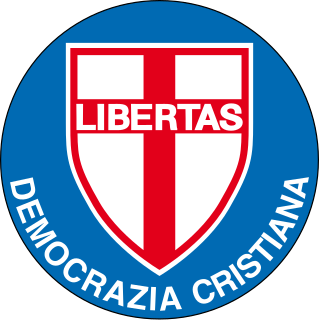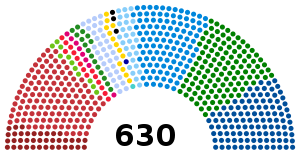
National Alliance was a conservative political party in Italy.

The Union of the Centre, whose complete name is Union of Christian and Centre Democrats, is a Christian democratic political party in Italy. Lorenzo Cesa is the party's current secretary; Pier Ferdinando Casini was for years the most recognisable figure and de facto leader of the party, before eventually distancing from it in 2016. The UdC is a member of the European People's Party (EPP) and the Centrist Democrat International (CDI), of which Casini was president from 2004 to 2015.

After World War II and the overthrow of Mussolini's fascist regime, Italy's history was dominated by the Christian Democracy political party for 48 years—from the 1946 election until the 1994 election—while the opposition was led by the Italian Communist Party (PCI).

The Christian Democratic Centre was a Christian democratic political party in Italy from 1994 to 2002. The CCD was a member of the European People's Party (EPP).

A snap national general election was held in Italy on 21 April 1996 to elect members of the Chamber of Deputies and the Senate of the Republic. Romano Prodi, leader of the centre-left coalition The Olive Tree, won the election, narrowly defeating Silvio Berlusconi, who led the Pole for Freedoms centre-right coalition.

The Segni Pact, also called the Pact of National Rebirth, was a Christian-democratic, centrist and liberal political party in Italy, named after Mario Segni.

The Pole of Freedoms was a centre-right political and electoral alliance in Italy, launched at the 1994 general election by Silvio Berlusconi. Its counterpart in central and southern Italy was the Pole of Good Government.

The Pole of Good Government was a centre-right political and electoral alliance in Italy, launched at the 1994 general election by Silvio Berlusconi. Its counterpart in Northern Italy was the Pole of Freedoms.

The Alliance of Progressives, also known as simply the Progressives (Progressisti), was a centre-left to left-wing political and electoral alliance of political parties in Italy formed in 1994. The leader of the alliance was Achille Occhetto.

The Berlusconi III Cabinet was the cabinet of the government of Italy from 23 April 2005 to 17 May 2006. It was the 58th cabinet of the Italian Republic, and the second cabinet of the XIV Legislature.

A snap general election was held in Italy on 13–14 April 2008. The election came after President Giorgio Napolitano dissolved Parliament on 6 February 2008, following the defeat of the government of Prime Minister Romano Prodi in a January 2008 Senate vote of confidence and the unsuccessful tentative appointment of Franco Marini with the aim to change the current electoral law. Under Italian law, elections must be held within 70 days of the dissolution. The voting determined the leader of Italy's 62nd government since the end of World War II. The coalition led by ex-Prime Minister Silvio Berlusconi from The People of Freedom party defeated that of former Mayor of Rome, Walter Veltroni of the Democratic Party.

The Berlusconi I Cabinet was the 51st cabinet of the Italian Republic. It held office from 11 May until 22 December 1994.

The Berlusconi II Cabinet was the 57th cabinet of the Italian Republic and the first cabinet of the XIV Legislature. It took office following the 2001 elections, and held office from 11 June 2001 until 23 April 2005, a total of 1,412 days, or 3 years, 10 months and 12 days. It held office for the longest period in the history of the Republic, and for the second longest period in the history of unified Italy since 1861. During its long tenure, its composition changed significantly. Following the poor performance of the centrist parties in the Italian regional elections of 2005, most of the ministers of the Union of Christian and Centre Democrats and the New PSI resigned from the government, which was succeeded by the Berlusconi III Cabinet.

The Lombard regional election of 1995 took place on 23 April 1995. The 6th term of the Regional Council was chosen.

The political career of Silvio Berlusconi began in 1994, when Berlusconi entered politics for the first time serving intermittent terms as Prime Minister of Italy from 1994 to 1995, 2001 to 2006 and 2008 to 2011, his career was racked with controversies and trials; amongst these was his failure to honour his promise to sell his personal assets in Mediaset, the largest television broadcaster network in Italy, in order to dispel any perceived conflicts of interest.

The Pole for Freedoms was a centre-right political and electoral alliance in Italy, which was active from 1996 to 2001. It included Forza Italia (FI), the National Alliance (AN), Union of the Centre (UdC), Christian Democratic Centre (CCD), United Christian Democrats (UCD), and Pannella–Sgarbi List.

A general election took place on 24–25 February 2013 to determine the 630 members of the Chamber of Deputies and the 315 elective members of the Senate of the Republic for the 17th Parliament of the Italian Republic.
The centre-right coalition is a political alliance of political parties in Italy, active—under several forms and names—since 1994, when Silvio Berlusconi entered politics and formed his Forza Italia party.

The Italian Electoral law of 2017, colloquially known by the nickname Rosatellum bis or simply Rosatellum, after Ettore Rosato, the Democratic leader in the Chamber of Deputies who first proposed the new law, is a parallel voting system, which act as a mixed system, with 37% of seats allocated using a first past the post electoral system and 61% using a proportional method, with one round of voting. The Senate and the Chamber of Deputies did not differ in the way they allocated the proportional seats, both using the largest remainder method of allocating seats.

Lombardy renewed its delegation to the Italian Senate on March 27, 1994. This election was a part of national Italian general election of 1994 even if, according to the Italian Constitution, every senatorial challenge in each Region is a single and independent race.






































